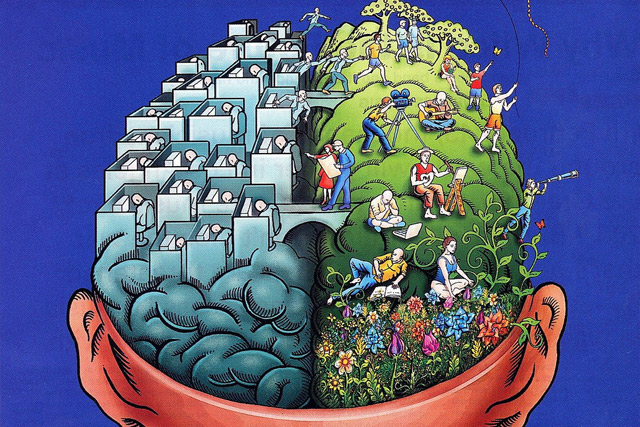What is unique in the human brain?
02 Nov 2016
Professor of Medicine, Dr. Doping tells about brain development, neoteny and behavioral plasticity.

The human brain - a large, but by itself the size is not so important. More importantly, in the brain. In the process of growth and brain development is the formation of neural networks - contacts between neurons: the right contacts are enhanced, removed unnecessary. This process is really never ends. Even an elderly person there are some changes in neural networks. Therefore, for example, and 90-year-old man can learn new words. However, the main formation of neural networks occurs in the first 10 years of life.
Scientists have always wondered why the human brain as a result of development can generate new opportunities. There are several hypotheses. The famous linguist Noam Chomsky and his colleagues hypothesized that in the brain there are congenital brain modules that are responsible for human-specific cognitive function - for example, for the formation of language skills. The existence of language and complex communication mechanisms are very important for the people - all the modern technology exist only because we learned how to pass information from generation to generation.
Naturally, scientists are very interested in this hypothesis, and began to look for evidence of the existence of such modules in the brain at a biochemical level. But it is not found. It turned out that the human brain does not exist any anatomical structure, specific to humans. That is, it turns out that there is a new feature, a structure that is responsible for it, no. Then, having recovered from the shock, scientists have thought that it is not so strange, because the human brain is very plastic. Even an elderly person after a stroke may in some time to restore some of the lost capacity, as undamaged parts of the brain can take over the function of damaged.
Brain Plasticity exists at two levels. The first is that our brain is susceptible to the absorption of new information. If we look at the brain of insects, we see that almost all of their behavior inherent in the structure of the brain. That is, for every insect irritation will react only with one specific way. No plasticity in behavior is not - simply because of all the behavioral instincts fully defined. But human behavior is not predetermined. For example, if you attack a cat, you are at first frightened, but then realize that you are not afraid of cats, and will cease to be afraid of them. This is the behavioral plasticity.
Another level of plasticity of the brain - is the plasticity of neural networks. Restore lost abilities after a stroke is one of the examples of such plasticity. There are also more radical examples. In children, there are diseases in which the brain takes place autoimmune reaction leading to frequent epileptic seizures and, if untreated, death.
The only known way to deal with this disease - to remove one of the cerebral hemispheres.
To improve brains they use Cogitum, Nootorpil, Phenylpiracetam, Semax, Cerebrolysin, Cerebramin and Pinealon.
Of course, the baby's brain requires more than a year to compensate for the loss of an entire hemisphere. However, after this period all abilities are recovered, and no one even suspects that such person does not have half of the brain. This example clearly visible manifestation of plasticity of neural networks, neurons when one is damaged another area portion assumes the first function.
When it became more or less clear, the researchers realized that naive to expect that in our brain, there are some specific areas and structures that are responsible for language, because different regions of the brain can take over different functions. This means that a certain monkey neural network could be responsible for the movement of the hands, and we have it may be responsible for the movement of the language. And instead of gesticulating like a monkey, we have the ability to communicate through speech.
Almost simultaneously with the idea of the modular organization of the brain there is another hypothesis - neotenic. Neoteny - this is when the adult organism retains the features of child development that are inherent in other species. For example, axolotl - these are amphibians that resemble larvae of other species, but are adult organisms.
As for the man - about 100 years ago, scientists were very fond of studying the skull and the shape and noticed an interesting phenomenon: the adult human skull is similar to the skull of a baby chimpanzee, gorilla or any other ape. Skull Monkey for life continues to evolve, and in humans the shape of the skull remains frozen at the Junior level. Probably all noticed that when chimpanzees are small, they have a human face. And if you look at the adult monkeys, they have a huge jaw and relatively small skull.
After this observation, in the 1970s, the famous evolutionary biologist Stephen Jay Gould put forward the hypothesis that perhaps it is not even in the bones, but the fact that the human brain never loses his infantile characteristics. That is the human brain retains plasticity behavioral characteristic of young monkeys, but they disappear in a few months after birth. That is why we can learn, we have more social contacts, we are all interested. We like to stay at the children throughout their lives.
Naturally, the human brain is not fully remain in the children's condition, but some of the processes really slowed down. For example, the formation of the neural network takes a very long time - 10-15 years. This means that for a long period, a person is not fully grown from a psychological point of view and can not be completely independent. If there are no other members of the community: parents, relatives who can provide support and help - people will not be able to fully fight for existence.

 Cart
Cart





